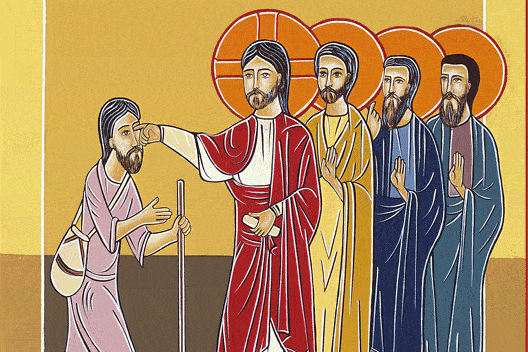
By Deacon Ron Hassarati
We have reached the Healing of the Blind Man which, in the Maronite Liturgical tradition, is the last Sunday before Hosanna Sunday.
We began Lent with Cana Sunday to emphasise that Lent is about transformation. In the same way that Jesus transformed water into wine he can transform the water of our sinful lives into the wine of new life.
Cana Sunday was followed by the Healing of the Leper, the Healing of the Hemorrhaging Woman, the Prodigal Son and the Healing of the Paralytic.
These Sundays reveal that Christ came to transform both body and soul through mercy manifested in sin and sickness. The Healing of the Blind Man concludes these Sundays with judgement upon those who recognise in these signs that Jesus is the Messiah and those who fail to do so.
Jesus’ healing of the blind man caused controversy because it was performed on the Sabbath. So “the Jews” question he and his parents about Jesus because, “the Jewish leaders…had decided that anyone who acknowledged that Jesus was the Messiah would be put out of the synagogue.” (John 9:22).
They had also decided that Jesus was a sinner and could not be from God because he did not keep God’s commandments (John 9:16, 24). John is not being antisemitic by his criticism of “the Jews” however, he is being critical of a religious attitude, personified and exemplified in them, that is so secure in its own self-righteousness, moral superiority and theological worldview that it falsely imagines it has no need of God’s saving mercy.
This attitude is the cause of a spiritual blindness that, in the name of religion, closes one to God by mistakenly judging God’s mercy and goodness as evil and sinful. Thus the Pharisees insult the blind man and say to him, “You are this fellow’s disciple! We are disciples of Moses! We know that God spoke to Moses, but as for this fellow, we don’t even know where he comes from.” (John 9:28-29).
Juxtaposed with the attitude of the Jews and the Pharisees, is the attitude that is personified in the poor blind man who, in Jewish society of that time had no moral, social or religious status. He lived at the bottom of the social pyramid – and was considered by the Jews “a sinner through and through” (John 9:34). Yet it was this “sinner” who came to belief in Jesus and worshipped him (John 9:38) while the Jews and the Pharisees remained in their unbelief.
It was the extreme need of the blind man that gave him the humility and openness to reach out to Christ while the smug piety of “the Jews” kept them blind to the Light of what God was doing in history. The theme of the “sinner” getting it right and the “righteous” getting it wrong is one of the major themes of the Gospels.
It is the repentant sinner, who is aware of his or her poverty and brokenness, who is open to receiving God’s mercy, while the righteous are closed to the Divine healing because they do not think they need it. Or in the words of Jesus: “It is not the healthy who need a doctor, but the sick. I have not come to call the righteous, but sinners.”
It is the blind beggar who is the unlikely hero in the story, as was the Prodigal Son, the humble tax-collector, the sinful woman who washed Jesus’ feet and the woman caught in adultery. It is only when we bring to Christ our spiritual sickness, that we will experience his power to transform our lives and only then can we truly acknowledge him as the Messiah.
We must always beware of falling into the trap, set by Satan, that allows our piety to blind us to the reality of our sinfulness and need for mercy. As Jesus says: “It is for judgement that I have come into the world so that those without sight may see and those with sight turn blind”.
Hearing this some Pharisees who were present said to Him, “We are not blind, surely?” Jesus replied: “Blind? If you were you would not be guilty, but since you say, “we see”, your guilt remains.” (John 9: 39-41). In the end the paradoxical truth of Christianity is that we only come to see the Light of Christ through the darkness of our sin not in spite of it. We can share in the resurrection of Christ only through sharing in his crucifixion – and that is the great mystery we will celebrate at Easter.
Deacon Ron Hassarati is a secondary Religious Education teacher for over 30 years at the Maronite College of the Holy Family Harris Park. He was ordained a Deacon for the Maronite Eparchy in 2019, he is married with three children.
